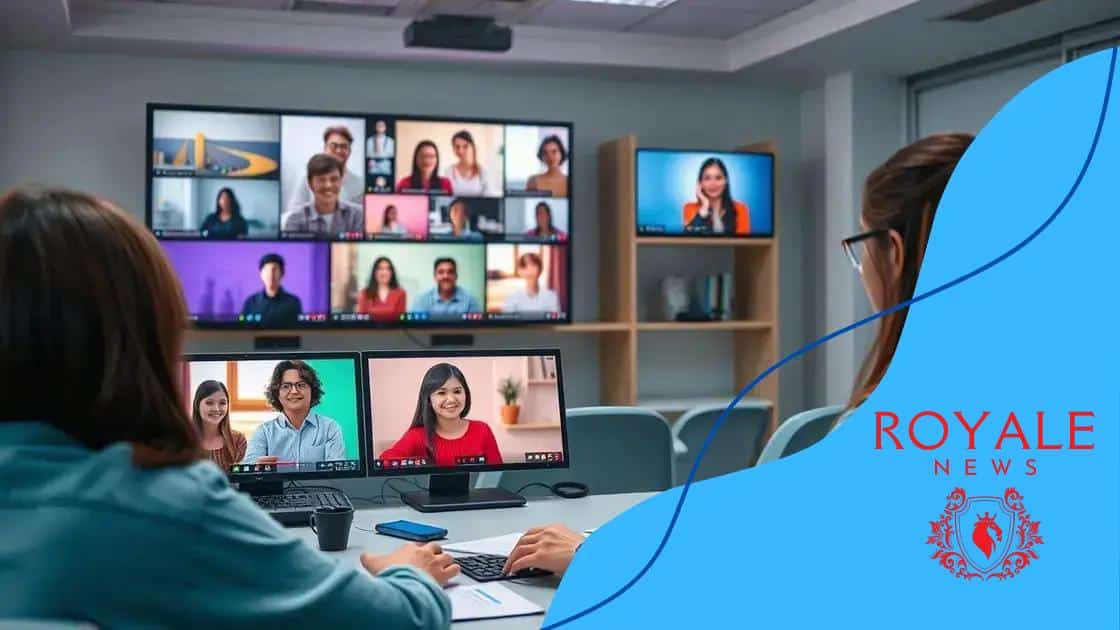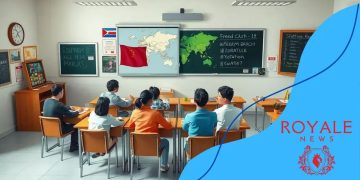Remote learning tools and best practices to enhance education

Evaluating the effectiveness of remote learning strategies involves setting clear objectives, gathering student feedback, analyzing data, and collaborating with peers to enhance teaching approaches and improve student outcomes.
In today’s rapidly changing educational landscape, remote learning tools and best practices are essential for effective online teaching. Have you wondered how these tools can transform your learning experience? Let’s dive into the world of virtual education.
Understanding remote learning tools
Understanding remote learning tools is essential for both educators and students. These tools help create an engaging and effective learning environment that bridges the gap between traditional and online education. Let’s explore how remote learning tools can enhance your online educational experience.
Types of Remote Learning Tools
There are various types of remote learning tools available today. Each serves a specific purpose and helps in delivering lessons effectively. Some common categories include:
- Learning Management Systems (LMS): Platforms like Moodle and Canvas allow teachers to create courses and manage student progress.
- Video Conferencing Software: Tools such as Zoom and Microsoft Teams enable live classes and discussions.
- Collaboration Tools: Google Workspace and Microsoft 365 provide a space for students to work together on projects.
These tools not only facilitate communication but also provide resources that make learning more interactive. For instance, video conferencing allows students to engage in real-time discussions, promoting a sense of community even from a distance.
Choosing the Right Tool
When selecting remote learning tools, consider your needs. Ask yourself:
– What features are essential for my courses?
– How easy is it for students to navigate the platform?
Each tool has its strengths, so choosing the right one helps ensure a smooth learning experience for everyone involved. Remote learning tools should be user-friendly and promote active participation among students.
Moreover, it’s important to keep up with the latest trends and updates in technology. The world of online education is always evolving, and being aware of new tools can give you an edge in creating an engaging curriculum.
Essential software for effective online classes
Essential software for effective online classes plays a crucial role in creating an engaging learning environment. Selecting the right tools can enhance the learning experience for both teachers and students. Here’s an overview of the key software options available to support online education.
Learning Management Systems
One type of essential software is the Learning Management System (LMS). These platforms help organize courses and track student progress. Popular LMS options include:
- Moodle: An open-source platform that offers flexibility and customization.
- Blackboard: Known for its user-friendly interface and robust features.
- Canvas: Offers excellent integration with other tools and a modern design.
Using an LMS can streamline communication and make it easier to share materials with students. It creates a centralized hub for all learning activities.
Video Conferencing Tools
Next, consider video conferencing tools. These applications allow real-time interactions during classes. Examples of effective video conferencing tools include:
- Zoom: Widely used for its functionality and ease of use.
- Google Meet: Integrates well with Google apps, making it convenient for users.
- Microsoft Teams: Combines chat, video calls, and file sharing in one platform.
Video conferencing is essential for engaging students in discussions, asking questions, and collaborating on group projects. It simulates a classroom environment, fostering connection among peers.
Another important category is collaborative tools. These software solutions encourage teamwork and interaction, enhancing the overall learning experience. Popular options include Google Workspace and Microsoft 365, which allow users to create and edit documents, spreadsheets, and presentations together in real time.
Ultimately, choosing the essential software tools that best fit your teaching style and your students’ needs is key. The right mix of software can lead to more effective online classes and improve student engagement.
Best practices for engaging remote students

Best practices for engaging remote students are crucial for keeping learners involved in their online education. With the right strategies, teachers can create a lively and interactive virtual classroom that enhances learning outcomes. Here are some effective methods to keep students engaged.
Interactive Learning Activities
Incorporating interactive learning activities is one of the best ways to engage students. These activities can spark interest and prompt discussion among students. Some great ideas include:
- Quizzes and Polls: Use tools like Kahoot or Mentimeter to create fun quizzes. They can serve as quick reviews and keep students alert.
- Group Projects: Assigning group work encourages collaboration. Students can use video calls to communicate and share ideas.
- Discussion Boards: Foster a sense of community by creating forums where students can express thoughts and ask questions.
These activities help maintain attention and encourage participation, leading to a better learning experience.
Maintain Clear Communication
Another important aspect is maintaining clear communication. Let students know what to expect through regular updates and check-ins. Use multiple channels to communicate the course objectives and deadlines. Consider hosting weekly virtual office hours where students can ask questions or seek help. This approach builds rapport and makes students feel supported.
Offering feedback is also key. Providing timely responses to assignments informs students about their progress and areas for improvement. Positive reinforcement encourages further participation.
To enhance engagement, leverage technology effectively. Utilize tools like screen sharing during lessons to illustrate concepts clearly. Integrating multimedia, such as videos and presentations, can make the content more dynamic. Additionally, creating a welcoming atmosphere encourages students to voice their ideas freely.
Engaging remote students requires creativity and flexibility in teaching approaches. By implementing interactive activities and maintaining communication, educators can foster a supportive online learning environment.
Creating interactive content for remote learning
Creating interactive content for remote learning is key to engaging students and enhancing their educational experience. By developing materials that capture attention, educators can foster a lively atmosphere in the virtual classroom. Here are some effective strategies for making learning more interactive.
Utilize Multimedia Resources
One way to enhance remote learning is by incorporating multimedia resources. Videos, infographics, and podcasts can present information in varied formats, catering to different learning styles. For instance, educational videos can clarify complex topics and provide visual context.
Additionally, using animations can help illustrate processes and concepts in an engaging way. These multimedia elements not only make lessons more attractive but also keep students interested.
Interactive Assignments
Another effective approach is to create interactive assignments that encourage participation from students. Examples of such assignments include:
- Interactive quizzes: Tools like Quizlet and Kahoot allow teachers to create fun quizzes that provide immediate feedback.
- Virtual escape rooms: These activities require students to solve puzzles collaboratively, promoting teamwork.
- Discussion prompts: Pose open-ended questions that invite students to share their thoughts on a topic, fostering dialogue.
Assignments like these encourage collaboration and critical thinking while keeping the learning experience fresh and engaging.
Moreover, using interactive tools like breakout rooms during live sessions allows students to engage in smaller group discussions. These spaces create opportunities for active participation, making everyone feel included in the learning process. Educators can assign specific tasks within these rooms to encourage discussion between peers.
Incorporating gamification elements can be another way to increase engagement. Consider rewards, leaderboards, or badges for completing tasks, which can motivate students to participate actively.
Evaluating the effectiveness of remote learning strategies
Evaluating the effectiveness of remote learning strategies is essential for ensuring that students receive the best educational experience possible. This process helps educators understand what works and what needs improvement.
Setting Clear Objectives
To start, it’s important to set clear objectives for each course. Knowing what you want students to achieve can guide your evaluation process. These objectives should be specific, measurable, achievable, relevant, and time-bound (SMART). This way, you have concrete benchmarks to assess student progress.
Student Feedback
Gathering feedback from students is another crucial aspect of evaluating remote learning strategies. Consider using surveys or anonymous questionnaires to understand their experiences. Key questions might include:
- How engaging do you find the course materials?
- What challenges are you facing during remote learning?
- Do you feel you are learning effectively?
By collecting this feedback, you can identify areas that may need adjustments, ensuring that students’ voices are heard.
Data Analytics
Another effective method involves using data analytics tools. These tools can track student participation, assignment completion rates, and overall performance. Review patterns in this data to determine if certain strategies lead to better outcomes. Look for trends, such as:
- Attendance during live sessions: Are students consistently logging in?
- Assignment performance: Do scores reflect the expected learning outcomes?
- Engagement levels: Are students participating in discussions and group activities?
Analyzing this data can offer valuable insights into the effectiveness of your remote learning strategies.
In addition, consider peer evaluations among educators. Sharing experiences and insights can foster collaborative improvement in teaching methods. This collaboration can also lead to the discovery of innovative approaches that may enhance student engagement and learning.
Lastly, ongoing evaluation is crucial. Implementing regular check-ins allows for timely adjustments to teaching strategies and course materials. Continuous reflection and adaptation help create a dynamic learning environment that supports all students effectively.
FAQ – Frequently Asked Questions about Evaluating Remote Learning Strategies
Why is evaluating remote learning strategies important?
Evaluating remote learning strategies helps educators determine what is effective and what needs improvement, ensuring a better educational experience for students.
How can I gather feedback from students?
You can use surveys or anonymous questionnaires to ask students about their experiences, engagement, and any challenges they face in remote learning.
What data should I analyze to evaluate effectiveness?
Analyze data such as attendance, assignment completion rates, and student performance to understand the impact of your remote learning strategies.
How can peer collaboration enhance evaluation efforts?
Collaborating with fellow educators allows for sharing insights and innovative practices, leading to improved remote teaching methods and student outcomes.





